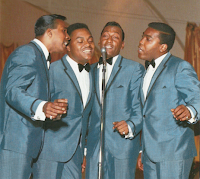1. The leakage of the rest of the band onto the bass track. Most of the recording of those early Motown hits recorded in Detroit were done on an 8 track tape machine, which means that many of the instruments had to be recorded together on the same tracks. The bass was the exception as it always had its own track, but that didn't mean that it was totally isolated. Since it was recorded through an amp, you can hear the rest of the band playing as well, which is something that we probably wouldn't stand for today. Didn't seem to hurt anything here.
2. Listen to how Jamerson's articulations change throughout the song. Sometimes he has a smooth release and sometimes it's staccato and chopped off. This is something else we would probably replace today, asking him to play it one way or another throughout the song.
3. There's a mistake that Jamerson makes throughout the first third of the song as he plays a major against a Dm (the third chord in the pattern) over and over. At some point he realizes the mistake and makes the change (it's only one fret difference). Not that this has ever bothered the millions of listeners that have enjoyed the song. In fact, if it weren't for the isolated track, no one would probably hear the difference.
This track is a perfect example of how modern production techniques have changed from the 1960s. Today we look for more precision and isolation, but we often lose the feel and groove as a result. That said, the track is proof that a hit is still a hit, mistakes and all.
----------------------------------
You should follow me on Twitter for daily news and updates on production and the music business.
Don't forget to check out my Music 3.0 blog for tips and tricks on navigating social media and the new music business.



1 comment:
This is why i prefer live bands (mostly rock for concerts). While we lost the imperfections from recorded songs, we still have great live shows.
Post a Comment